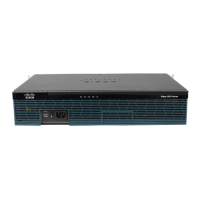322
Cisco 3900 Series, Cisco 2900 Series, and Cisco 1900 Series Integrated Services Routers Generation 2 Software Configuration Guide
Chapter Administering the Wireless Device
Configuring a System Name and Prompt
DETAILED STEPS
When you set the system name, the name is also used as the system prompt.
To return to the default hostname, use the no hostname command in global configuration mode.
Understanding DNS
The DNS protocol controls the Domain Name System (DNS), a distributed database with which you can
map hostnames to IP addresses. When you configure DNS on the wireless device, you can substitute the
hostname for the IP address with all IP commands, such as ping, telnet, connect, and related Telnet
support operations.
IP defines a hierarchical naming scheme that allows a device to be identified by its location or domain.
Domain names are pieced together with periods (.) as the delimiting characters. For example,
Cisco Systems is a commercial organization that IP identifies by a com domain name, so its domain
name is cisco.com. A specific device in this domain, such as the File Transfer Protocol (FTP) system, is
identified as ftp.cisco.com.
To keep track of domain names, IP has defined the concept of a domain name server, which holds a cache
(or database) of names mapped to IP addresses. To map domain names to IP addresses, you must first
identify the hostnames, specify the name server that is present on your network, and enable the DNS.
This section contains the following configuration information:
• Default DNS Configuration, page 323
• Setting Up DNS, page 323
• Displaying the DNS Configuration, page 324
Command Purpose
Step 1
configure terminal Enters global configuration mode.
Step 2
hostname name Manually configures a system name.
The default setting is ap.
Note When you change the system name, the wireless device radios reset,
and associated client devices disassociate and quickly reassociate.
Note You can enter up to 63 characters for the system name. However,
when the wireless device identifies itself to client devices, it uses
only the first 15 characters in the system name. If it is important for
client users to distinguish between devices, make sure that a unique
portion of the system name appears in the first 15 characters.
Step 3
end Returns to privileged EXEC mode.
Step 4
show running-config Verifies your entries.
Step 5
copy running-config startup-config (Optional) Saves your entries in the configuration file.

